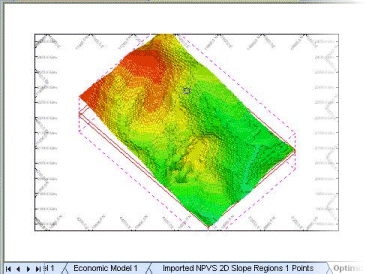|
|
Pit Optimization Settings: Sequencing An explanation of fields and properties |
Pit Optimization Settings: Sequencing

To access this dialog:
-
Using the Optimization control bar, select Ultimate Pit | Settings and select the Sequencing tab.
The sequencing options are different for NPV optimization than for blending. For a more detailed explanation of the overall processes involved, see Pit Optimization.
Optimize NPV (LG Method)
LG phases can be obtained by varying net profits (block values), product prices or mining costs.
Use profit factors: select if your primary goal is to obtain high NPV.
Use price factors: select if your primary goal is to obtain high NPV and you are interested in “price sensitivity” analysis.
Use mining cost factors: if you are interested in “mining cost sensitivity” analysis.
Maximum revenue factor (minimum cost factor for option 3): parameter defining the largest LG phase (ultimate pit). Revenue factors larger than 100% and cost factors less than 100% usually result in ultimate pits larger than the pit corresponding to the reference prices and costs. This is convenient for sensitivity analysis. If your goal is just to obtain NPV optimal extraction sequence, set the factor to 100%. Note that setting a revenue factor to less than 100% or cost factor to more than 100% may result in an ultimate pit smaller than the one corresponding to the reference prices and costs.
Incremental factor:
parameter defining a percentage reduction in revenues or costs between
two consecutive phases. A small reduction, say 1%, will usually result
in a greater number of phases than a larger reduction, say 5%.
OES Search Based on: the Ultimate Pit Optimal Extraction Sequence
search can be based on proximity values or lookahead values:
-
TheProximity value for block B is a combination of its intrinsic value and its proximity to the current block A.
-
The Lookahead value for a block B is a discounted sum of profits to be had from B and a set of blocks contained in a downward looking cone with a vertex at B. Use the slider to determine the extent of the lookahead 'cone' as described by number of benches.
Find out more about more about the Ultimate Pit Optimal Extraction Sequence...
Optimize Blending
Blending optimization is performed by creating a blended extract sequence from blocks that are available on the current surface.
Select targets: click Add to add a new target, select a label and click Edit to modify an existing target, or select a label and click Delete to remove an existing target.
Search parameter: set to '0' for a quick search. Increase the value of the parameter if the search is unsuccessful or to check if there is a better solution. The computing time increases with the parameter value. The extraction sequence obtained with the parameter values between 1 and 10 is never worse than the extraction sequence obtained by the quick search (the parameter set to '0'), but a smaller positive parameter, say '1', may produce a better solution than a greater parameter, say '10'.
Optimize NPV Notes
-
Suppose you have chosen Use price factors, set the Maximum revenue factor to 120% and set the Incremental factor to 5%: the program will attempt to calculate 24 phases, the largest one corresponding to all reference prices multiplied by 1.2, the second largest corresponding to all reference prices multiplied by 1.15, and so on until the smallest phase corresponding to all reference prices multiplied by 0.05. The actual number of phases generated by the program may be less than 24 as pits corresponding to different prices may be identical.
The modifying factors are applied slightly differently for each parameterization option. The profit factors are applied to blocks having positive values (ore blocks) leaving the values of waste blocks unchanged. The price factors are applied to blocks with positive gross revenue and if the modified revenue is less than the block's processing cost, the block value is set to its mining cost (the block is treated as waste). The mining cost factors are applied to all blocks, ore and waste alike.
-
Every economic model has a maximum number of phases that can be generated for the model, and this maximum number can never be exceeded regardless of the values of the two factors.
-
For profit and price options, the maximum number of phases that the program will attempt to generate equals the Maximum revenue factor divided by the specified Incremental factor. For mining cost factors, the maximum number of phases is set to 100.
-
In many cases, but not always, greater numbers of phases tend to lead to an extraction sequence with a higher NPV.
|
|
Related Topics |
|
|
Pit Optimization
Essentials |
Copyright © Datamine Corporate Limited
JMN 20065_01_EN

